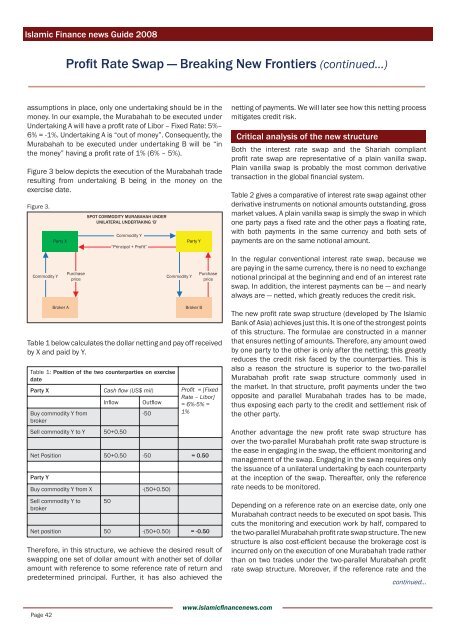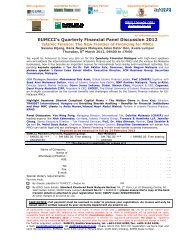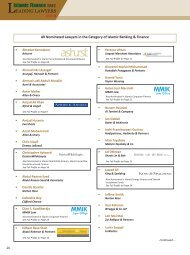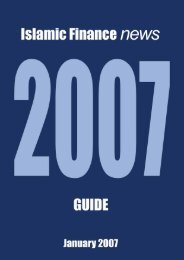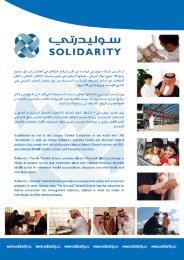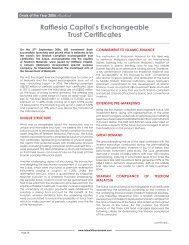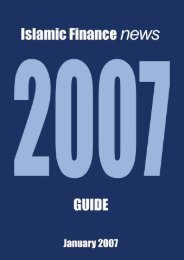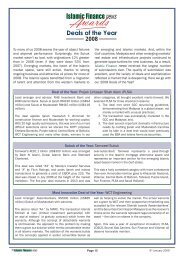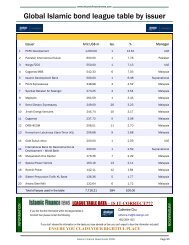You also want an ePaper? Increase the reach of your titles
YUMPU automatically turns print PDFs into web optimized ePapers that Google loves.
<strong>Islamic</strong> <strong>Finance</strong> news Guide 2008<br />
Page 42<br />
Profi t Rate Swap — Breaking New Frontiers (<strong>continued</strong>...)<br />
assumptions in place, only one undertaking should be in the<br />
money. In our example, the Murabahah to be executed under<br />
Undertaking A will have a profi t rate of Libor – Fixed Rate: 5%–<br />
6% = -1%. Undertaking A is “out of money”. Consequently, the<br />
Murabahah to be executed under undertaking B will be “in<br />
the money” having a profi t rate of 1% (6% – 5%).<br />
Figure 3 below depicts the execution of the Murabahah trade<br />
resulting from undertaking B being in the money on the<br />
exercise date.<br />
Figure 3.<br />
Commodity Y<br />
Commodity Y<br />
Party X Party Y<br />
“Principal + Profit”<br />
Purchase<br />
price<br />
Table 1 below calculates the dollar netting and pay off received<br />
by X and paid by Y.<br />
Table 1: Position of the two counterparties on exercise<br />
date<br />
Party X Cash fl ow (US$ mil) Profi t = [Fixed<br />
Buy commodity Y from<br />
broker<br />
Sell commodity Y to Y 50+0.50<br />
SPOT COMMODITY MURABAHAH UNDER<br />
UNILATERAL UNDERTAKING ‘B’<br />
Infl ow Outfl ow<br />
-50<br />
Rate – Libor]<br />
= 6%-5% =<br />
1%<br />
Net Position 50+0.50 -50 = 0.50<br />
Party Y<br />
Buy commodity Y from X -(50+0.50)<br />
Sell commodity Y to<br />
broker<br />
50<br />
Commodity Y<br />
Broker A Broker B<br />
Purchase<br />
price<br />
Net position 50 -(50+0.50) = -0.50<br />
Therefore, in this structure, we achieve the desired result of<br />
swapping one set of dollar amount with another set of dollar<br />
amount with reference to some reference rate of return and<br />
predetermined principal. Further, it has also achieved the<br />
www.islamicfi nancenews.com<br />
netting of payments. We will later see how this netting process<br />
mitigates credit risk.<br />
Critical analysis of the new structure<br />
Both the interest rate swap and the Shariah compliant<br />
profi t rate swap are representative of a plain vanilla swap.<br />
Plain vanilla swap is probably the most common derivative<br />
transaction in the global fi nancial system.<br />
Table 2 gives a comparative of interest rate swap against other<br />
derivative instruments on notional amounts outstanding, gross<br />
market values. A plain vanilla swap is simply the swap in which<br />
one party pays a fi xed rate and the other pays a fl oating rate,<br />
with both payments in the same currency and both sets of<br />
payments are on the same notional amount.<br />
In the regular conventional interest rate swap, because we<br />
are paying in the same currency, there is no need to exchange<br />
notional principal at the beginning and end of an interest rate<br />
swap. In addition, the interest payments can be — and nearly<br />
always are — netted, which greatly reduces the credit risk.<br />
The new profi t rate swap structure (developed by The <strong>Islamic</strong><br />
Bank of Asia) achieves just this. It is one of the strongest points<br />
of this structure. The formulae are constructed in a manner<br />
that ensures netting of amounts. Therefore, any amount owed<br />
by one party to the other is only after the netting; this greatly<br />
reduces the credit risk faced by the counterparties. This is<br />
also a reason the structure is superior to the two-parallel<br />
Murabahah profi t rate swap structure commonly used in<br />
the market. In that structure, profi t payments under the two<br />
opposite and parallel Murabahah trades has to be made,<br />
thus exposing each party to the credit and settlement risk of<br />
the other party.<br />
Another advantage the new profi t rate swap structure has<br />
over the two-parallel Murabahah profi t rate swap structure is<br />
the ease in engaging in the swap, the effi cient monitoring and<br />
management of the swap. Engaging in the swap requires only<br />
the issuance of a unilateral undertaking by each counterparty<br />
at the inception of the swap. Thereafter, only the reference<br />
rate needs to be monitored.<br />
Depending on a reference rate on an exercise date, only one<br />
Murabahah contract needs to be executed on spot basis. This<br />
cuts the monitoring and execution work by half, compared to<br />
the two-parallel Murabahah profi t rate swap structure. The new<br />
structure is also cost-effi cient because the brokerage cost is<br />
incurred only on the execution of one Murabahah trade rather<br />
than on two trades under the two-parallel Murabahah profi t<br />
rate swap structure. Moreover, if the reference rate and the<br />
<strong>continued</strong>...


